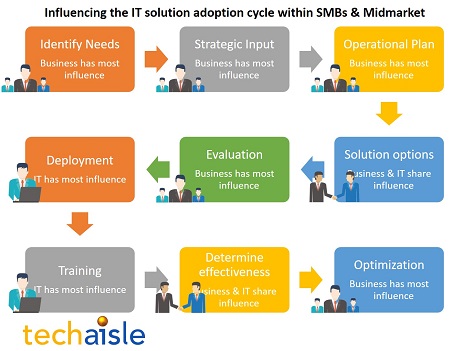Techaisle Blog
Role of BDMs in SMB IT solution adoption
Typically, IT suppliers focus on product or service transactions – the point at which a buyer commits to a contract with a specific seller. IT vendor compensation plans are structured around the transaction, and lead funnels captured in CRM and marketing systems coalesce around this event. And because IT professionals are often engaged in signing contracts for IT products and services, vendor sales and marketing initiatives often key on the IT function.
From a buyer’s perspective, though, the solution adoption cycle is much longer, and commitment to a specific product or service is less important than establishing the business context that drives the need for investment, and the processes needed to ensure that the business obtains anticipated value from this investment. Before they commit to a contract, organizations need to identify the need for a new solution, align the need with strategic and operational plans, and identify and evaluate solution options. Once the product/service is acquired, the buyer’s process continues: the business still needs to deploy the new technology, train IT and business users on its features, evaluate the effectiveness of the solution in meeting current requirements, and optimize the solution over time to maximize returns.
Techaisle conducted a unique survey of SMB organizations. To understand the current state and implications of distributed IT influence and authority, Techaisle surveyed roughly equal numbers of business decision makers (BDMs) and IT decision makers (ITDMs) across seven employee size categories, and then analyzed results to create a unified view of the new decision authority realities.
In Figure below, Techaisle illustrates the aggregate BDM/ITDM involvement in the stages in the SMB (1-999 employee size) IT solution adoption cycle. Although respondents were given the option of identifying one or more of five different positions (IT management, business management, senior executive management, IT suppliers and customers) active at each stage of the cycle, we have isolated the three roles – business management, IT management and executive management – who assert the most impact over the solution acquisition process.

As is seen in above figure, the initial stages of the process – the identification of the need for a new solution, and its evaluation within the context of corporate strategic and operational plans – is driven primarily by business management, with the involvement of senior executives, but with little input from IT. IT begins to become important to the process when the business is investigating the options available for a solution meeting its strategic and operational needs. IT often has primary responsibility for deployment of the solution and for training users on its features, and plays a prominent role in evaluating the success of the initiative. However, optimization is most often seen as a business management responsibility, implying organizations look for business process rather than IT improvement when they are optimizing IT/business solutions.
This is, or should be, a sobering view of business activity for IT suppliers. Most vendors are overjoyed when they “write the RFP,” or influence the evaluation of potential solution options. However, this chart demonstrates that there are several previous steps in the acquisition process – and that these steps are primarily controlled by BDMs. These lessons here, and throughout this document: IT vendors need to understand how to work effectively with BDMs, in terms and on issues that are relevant and important to BDMs, in order to exert the control needed to direct the solution acquisition process.
When you subscribe to the blog, we will send you an e-mail when there are new updates on the site so you wouldn't miss them.











